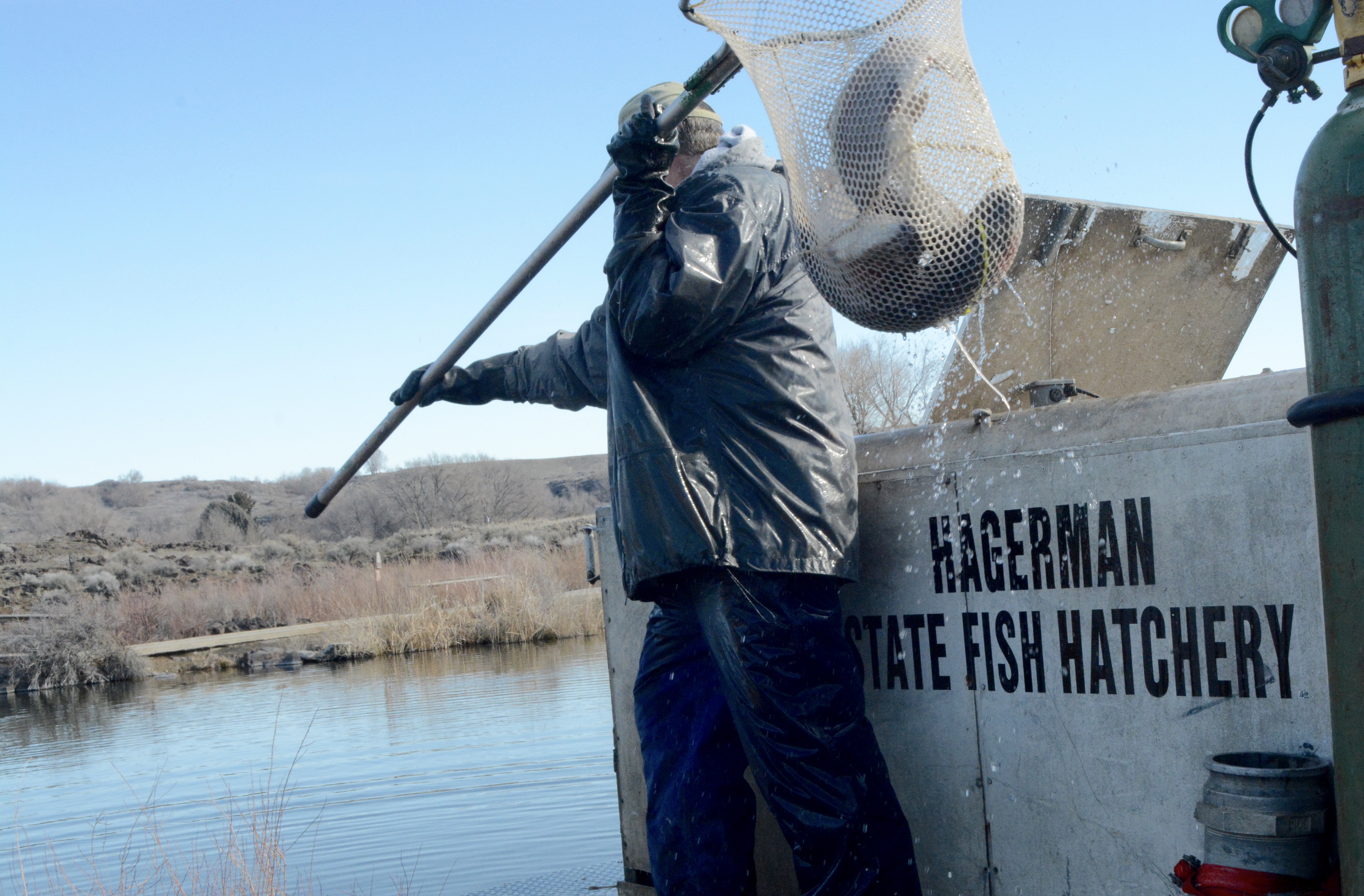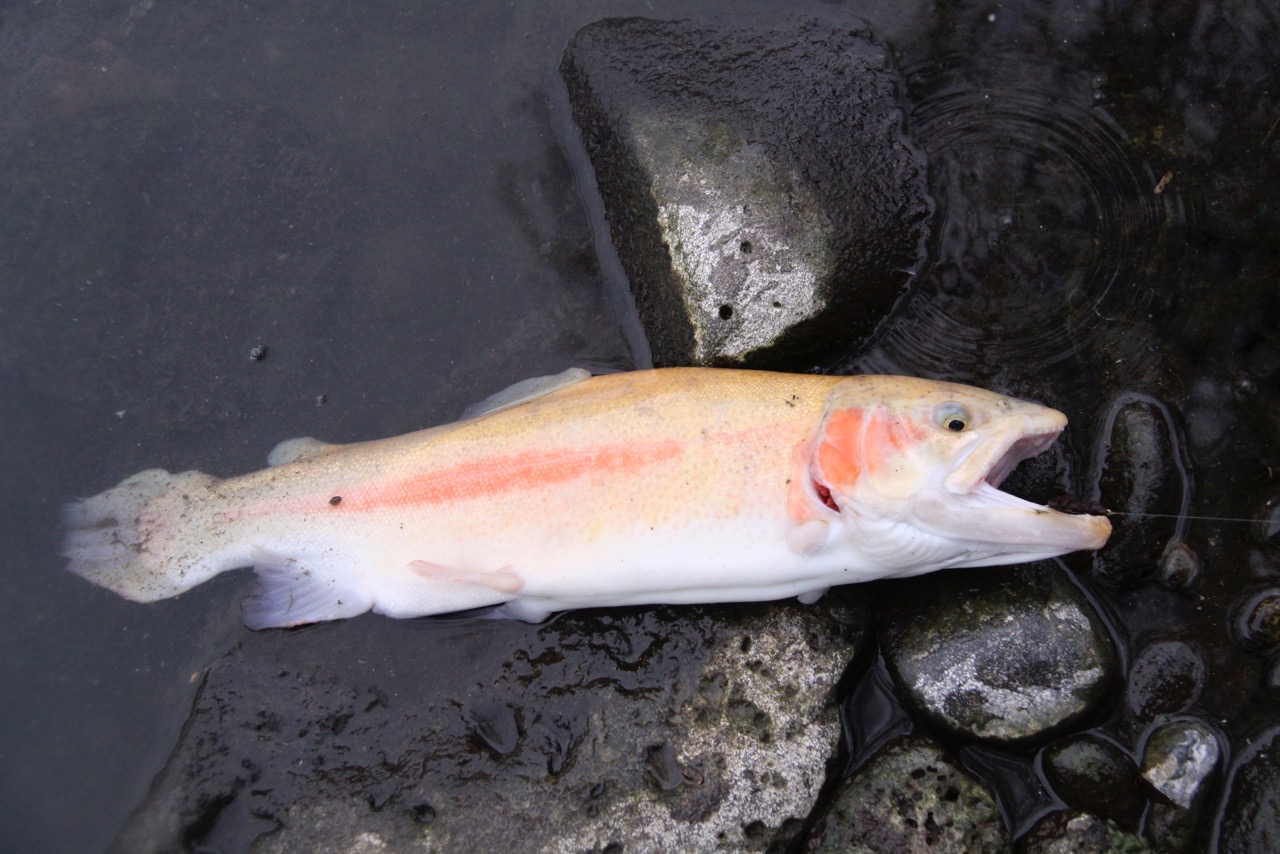The Hagerman Wildlife Management Area opened for fishing on March 1, and it has about a dozen ponds and lakes along with bathrooms, picnic tables, handicap accessible dock, fish-viewing pond and more.

The Hagerman area is a beautiful destination for sight seers, who gazing at springs spilling out of canyon walls into the Snake River. Those springs also create a perfect environment for growing trout, which are used to stock waters throughout southern Idaho.
Joe Chapman manages Idaho Fish and Game’s Hagerman hatchery, and he gives an insider’s look into the Hagerman area and sheds some light on a unique fishing opportunity the area offers – its famous yellow trout (or infamous if you’re unsuccessfully trying to catch one).

Q: What exactly is this trout? It’s not a true golden trout, although it’s commonly called that. Can we settle on calling it the Hagerman banana trout?
Chapman: The true golden trout is actually a subspecies of the rainbow trout and native to California. The fish we stock is a very rare mutation of a rainbow trout. Instead of the normal coloration most rainbow trout have, these fish have a yellow, or golden, color because they lack the melanin pigment.
They have been called yellow trout, palomino trout, and banana trout, and they occur throughout the United States. Several agencies use them in their stocking programs, so I don’t think it would be fair to call them “Hagerman” banana trout. A more common mutation among rainbow trout creates a blue phase, but I don’t know of any breeding programs for these fish, and I have been told they can’t reproduce.
Q: Do these yellow trout occur in the wild?
Chapman: Yes, but it is extremely rare you would ever see one. I tell people for every 5 million rainbow trout eggs we receive, we may get one yellow trout, and I may be short on that statement. The blue trout is more common, and for every 100,000 eggs we receive, you will get one blue trout.
Yellow trout are more common to find in a hatchery where they can be protected from predation. In the wild, their color makes them easy targets for aquatic predators and birds, so odds are against them surviving to adulthood.
I talked to my brother, Jerry, (manager at Fish and Game’s Niagara Springs Steelhead Hatchery), and he said yellows seem to be more prevalent in steelhead than in our Hayspur strain of rainbow trout. They may also be more prevalent in different strains of rainbow. I know they are also found in brown trout populations.
We regularly stock yellow trout in ponds on the Hagerman WMA and the Filer Ponds. If we have excess, we also stock them at Dierkes Lake and Dog Creek Reservoir and some ponds in eastern and western Idaho.
Q: Anglers seem to love these things. Other than appearance, is there any difference from a regular rainbow trout?
Chapman: Although most anglers I talk to think yellow trout fight better, look better, taste better and are more finicky, they are in reality, a rainbow trout. I like to jokingly tell people they are trout that have already been buttered.
Q: Care to share any secret angling tips?
Chapman: I’ve caught hundreds of them, and will admit they can be finicky if they were stocked some time ago, but so can a normal rainbow trout. The secret is to find out what they want, and that may mean digging deep into your tackle box.
If they were recently stocked, I’ve found they are not difficult to catch. However, the longer they are in the pond, the more difficult they become to catch. This is when you may have to throw the kitchen sink at them. I remember one year tossing lure after lure to a huge yellow trout that ignored everything. As a last resort, I tied on an ice-fishing micro-jig and hooked it. You never know what will work on a particular day.
What I’ve found works well for any trout in the area are gold spoons, such as Little Cleos, Thunderbolts, Kastmasters, and Daredevils, and plugs such as Rapalas. If you don’t get any hits after a few casts, move or try something else.
Most likely after you catch a couple, you’ll have to switch lures again because they’ve become educated. I’ve also caught them on spinners, such as Mepps and Panther-Martins, and also used small crappie jigs, such as tube jigs or maribou/deer hair jigs. I am a very impatient fisherman, so if I’m not catching fish, it’s time to move, or try something new.
I am also a staunch believer in polarized sunglasses. These eliminate the glare on the water and allow you to see the fish. Often, I can spot the fish in the water and throw ahead of them. The sunglasses allow me to set the hook as soon as I see the fish inhale my offering, which results in more hooked fish.
Another tip to remember, especially at this time of the year, is that fish are cold-blooded, or their body temperature is the same as the water they are in. When the water is very cold, they don’t move as quickly as they will in a couple months, so slow down your retrieve.
As the water warms, these fish will become much more aggressive and smack your offering. Knowing how a fish behaves at different water temperatures can make you a more successful fisherman.
Another point to remember as the temperatures warms you need to keep the trout catch cold if you plan to eat them. Put it on ice to keep the meat firm. Nothing ruins trout faster than heat.
Q: The Hagerman WMA opened for fishing on March 1. Can you tell us some details about fishing there, such as how many trout you stock every month?
Chapman: We follow a stocking request given to us by the regional fisheries managers. This year, we stocked about 5,500 fish into the WMA ponds before opener, and continue stocking about 1,800 fish each week.
In the summer, the water temperatures can get too warm to stock in certain ponds on the WMA, then stocking will be stopped until water temperatures cool.

Q: Any big fish planned to be stocked at the WMA this spring?
Chapman: We are very fortunate to have great relationships with the private hatcheries. We get our yellow trout eggs donated from Idaho Trout Company, and the large broodstock rainbows are donated from Clear Springs Trout Company.
This year, Clear Springs again donated over 750 large fish averaging 3 pounds each for the opening day, so there should be some remaining big fish to be caught as well. We also stocked Crystal Lake south of Wendell, and the Filer and Empire Ponds with these large fish in early February.
We are limited to stocking those lakes that have spring-water influence and are open at this time of year. As the waters warm, we try and distribute these large fish more equitably across southern Idaho waters.
Q: How’s the pond renovation at the WMA working out? Is it helping anglers, and any word on the bass pond?
Chapman: As far as removing the silt, I think that was successful. We created a deep-water area near the bank around the perimeter of the fishable area of Riley Pond, which holds trout better, especially in the summer. Overall, I think most people were happy with the work that was done, and they enjoyed the clear water again.
The pond renovation was also successful at removing unwanted carp, which compete with the juvenile bass and bluegill for food. We are trying to create a bass/bluegill fishery similar to the great fishery we had decades ago. The downside of the carp removal was an abundance of algae last summer, limiting the surface area available to fishing. However, this also provided a refuge for trout that were being pursued by white pelicans, making it more difficult to catch them.
We have established a small population of grass carp in most of the ponds, so we’ll see how effective they are at keeping the algae growth in check in upcoming years.
I can’t wait until the bass and bluegill recover. I didn’t see many people fishing the bass pond last year, probably because the fish were still small. With time, it should create a great fishing opportunity for bass and bluegill once again.

